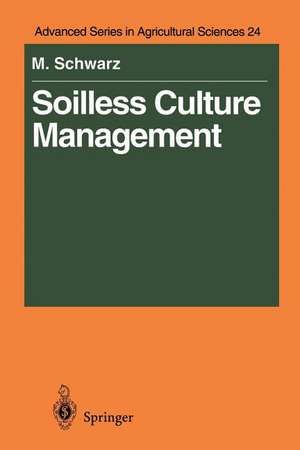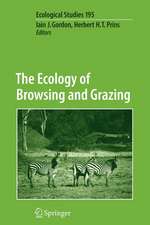Soilless Culture Management: Advanced Series in Agricultural Sciences, cartea 24
Autor Meier Schwarzen Limba Engleză Paperback – 8 dec 2011
This book will serve as an indispensable guide for students in the agriculture sciences, for agriculture instructors and soilless-culture farmers. It provides up-to-date information on optimal plant nutrition, deficiencies and toxicities of nutrients, plant growth media, optimal root environment, environmental control, carbon dioxide requirements, saline conditions and use of sewage in soilless culture. Other topics include economic aspects of hydroponics, new growth methods and an outlook for the future.
Din seria Advanced Series in Agricultural Sciences
- 15%
 Preț: 648.89 lei
Preț: 648.89 lei - 15%
 Preț: 640.06 lei
Preț: 640.06 lei - 15%
 Preț: 645.14 lei
Preț: 645.14 lei - 18%
 Preț: 887.05 lei
Preț: 887.05 lei - 15%
 Preț: 640.55 lei
Preț: 640.55 lei - 15%
 Preț: 637.93 lei
Preț: 637.93 lei - 15%
 Preț: 642.83 lei
Preț: 642.83 lei - 15%
 Preț: 641.53 lei
Preț: 641.53 lei - 15%
 Preț: 637.59 lei
Preț: 637.59 lei - 15%
 Preț: 653.46 lei
Preț: 653.46 lei - 15%
 Preț: 638.57 lei
Preț: 638.57 lei - 20%
 Preț: 546.85 lei
Preț: 546.85 lei - 15%
 Preț: 642.18 lei
Preț: 642.18 lei - 18%
 Preț: 888.49 lei
Preț: 888.49 lei - 15%
 Preț: 642.68 lei
Preț: 642.68 lei - 15%
 Preț: 643.48 lei
Preț: 643.48 lei - 20%
 Preț: 553.61 lei
Preț: 553.61 lei - 15%
 Preț: 644.49 lei
Preț: 644.49 lei - 15%
 Preț: 656.58 lei
Preț: 656.58 lei - 18%
 Preț: 940.72 lei
Preț: 940.72 lei - 15%
 Preț: 634.00 lei
Preț: 634.00 lei -
 Preț: 382.18 lei
Preț: 382.18 lei - 18%
 Preț: 890.54 lei
Preț: 890.54 lei
Preț: 636.45 lei
Preț vechi: 748.76 lei
-15% Nou
Puncte Express: 955
Preț estimativ în valută:
121.78€ • 127.16$ • 100.56£
121.78€ • 127.16$ • 100.56£
Carte tipărită la comandă
Livrare economică 15-29 aprilie
Preluare comenzi: 021 569.72.76
Specificații
ISBN-13: 9783642790959
ISBN-10: 364279095X
Pagini: 216
Ilustrații: XI, 197 p. 10 illus.
Dimensiuni: 155 x 235 x 11 mm
Greutate: 0.31 kg
Ediția:Softcover reprint of the original 1st ed. 1995
Editura: Springer Berlin, Heidelberg
Colecția Springer
Seria Advanced Series in Agricultural Sciences
Locul publicării:Berlin, Heidelberg, Germany
ISBN-10: 364279095X
Pagini: 216
Ilustrații: XI, 197 p. 10 illus.
Dimensiuni: 155 x 235 x 11 mm
Greutate: 0.31 kg
Ediția:Softcover reprint of the original 1st ed. 1995
Editura: Springer Berlin, Heidelberg
Colecția Springer
Seria Advanced Series in Agricultural Sciences
Locul publicării:Berlin, Heidelberg, Germany
Public țintă
ResearchCuprins
1 History.- 2 Types of Hydroponics and Nomenclature.- 2.1 Advantages and Disadvantages.- 3 Nutrients.- 3.1 The Elemental Composition of Plants.- 3.2 Macroelements.- 3.3 Microelements.- 3.4 Nonrequired Elements.- 3.5 Deficiency Symptom Considerations.- 3.6 Interaction Between Nutrients.- 3.7 Methods of Expressing Solution Concentration.- 3.8 Composition of the Nutrient Solution.- 3.9 Mixed Fertilizers.- 3.10 pH.- 3.11 Mobile and Immobile Nutrients.- 3.12 Nutrient Concentration and Yield.- 3.13 Preparation of Nutrient Concentrates.- 3.14 Foliar Nutrition.- 3.15 Nutrient Solution Analysis.- 4 Culture Methods.- 4.1 General Outlines.- 4.2 The Supporting Media.- 4.3 Sand Culture — Open System.- 4.4 Rockwool Culture — Open System.- 4.5 Gravel Culture — Closed System.- 4.6 Nutrient Film Technique (NFT) and Water Culture — Closed System.- 4.7 Water Culture — Closed System.- 4.8 Bag Culture — Open Systems.- 4.9 Other Systems.- 5 Water.- 5.1 General.- 5.2 The Process of Osmosis.- 5.3 Transpiration.- 5.4 Irrigation.- 5.5 Saline Water.- 5.6 Wastewater (Sewage).- 6 Carbon Dioxide.- 6.1 General Observations.- 6.2 CO2 Sources.- 6.3 Economics of CO2 Enrichment.- 7 Root Environment.- 7.1 Root Functioning.- 7.2 Relations of Nutrient Absorption.- 8 Plant Growth Effects and Plant Tests.- 8.1 Photosynthetic Efficiency.- 8.2 Harvest Index.- 8.3 Root-Shoot Relationships.- 8.4 Plant Tests: Choice of Tissue.- 8.5 Plant Analysis.- 8.6 Disease Control.- 9 Controlling Systems.- 9.1 Controllers.- 9.2 Temperature.- 9.3 Light.- 9.4 Automated Fertilizer Application.- 9.5 EC Controller (Conductivity).- 9.6 CO2 Controllers.- 9.7 DO Controller.- 10 Culture and Cultivation.- 10.1 Plants Adaptable to Hydroponic Culture.- 10.2 Tomato.- 10.3 Cucumber.- 10.4 Lettuce.- 10.5 Flowers.- 11 Establishinga Commercial Soilless Culture Unit.- 11.1 Economic Considerations.- 11.2 Increased Technical Demands on the Management.- 12 Some Future Aspects.- 12.1 Plant Nutrients.- 12.2 Initial Investment.- 12.3 Growth Media.- 12.4 Advanced Sand-Culture Methods.- References.










